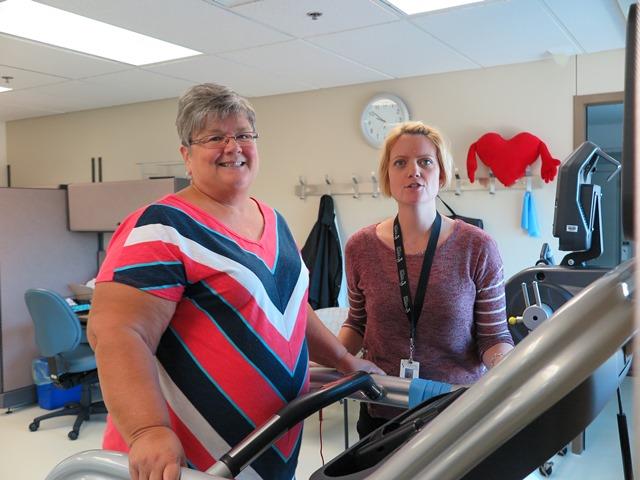Sheila Lucas had her first open heart surgery to repair a faulty mitral valve at age 21. Twenty years later, she underwent a second surgery, and now, at 64, is likely facing another heart operation.
To ensure she’s in the best shape possible, Sheila was referred to the Cardiac Rehabilitation and Secondary Prevention (CRSP) Program at #St. Joseph’s Hospital in London. There, she would find care and support that extended beyond the program and address health care needs she didn’t know she had.
Designed for individuals with known heart disease, the six-month CRSP program is a safe and effective way to overcome some of the physical and psychological complications of heart disease, limit the risk of developing more heart trouble, and assist in the return to an active social or work life after a heart event.
MORE: IMPROVING CARE FOR ELDERLY PATIENTS
For Sheila the program was an opportunity to improve her fitness level and reduce the strain on her heart. Tragically, her husband recently died suddenly, three months after being diagnosed with cancer. She was beginning the program in a vulnerable state, physically and emotionally.
“I was way overweight and my heart was bad. I couldn’t breathe. I couldn’t walk. My ankles were swollen. I couldn’t bend over to do my shoes up. I couldn’t go from the parking lot into the grocery store without feeling like I was dying. I couldn’t do anything,” says Sheila.
During the initial comprehensive assessment at the CRSP program, the news got worse. Sheila also had type 2 diabetes.
“It was a shock. I was on overwhelmed as it was – this was another blow.”
But working with the interdisciplinary cardiac rehab team, which includes physicians, kinesiolgists, psychologists, dietitian, nurse, and others, Sheila slowly began making progress. For the diabetes, she was enrolled in a class at the Diabetes Education Centre, also at St. Joseph’s Hospital.
Sheila’s care experience is part of a focus on integrated chronic disease management at St. Joseph’s Hospital, which is changing the ways programs think and patients are seen.
MORE: PUTTING THE FOCUS ON PATIENTS
For the most part, hospital programs have care delivery models divided by disease-specific silos, explains Mary Mueller, Director, Medicine Services at St. Joseph’s. For example, at St. Joseph’s Hospital there is the Centre for Diabetes, Endocrinology and Metabolism and CRSP. Traditionally, there has been little or no integration or coordination of care between these two programs even though their patients share common risk factors.
To break down the silos, a plan has been developed at St. Joseph’s to bring programs together in the care of patients with chronic diseases. First up was creating new care pathways for diabetes care and cardiac rehabilitation. Looking at identified risk factors seen in patients in both programs, a coordinated, collaborative care model was developed to optimize the care and service for these patients
It begins with a comprehensive medical assessment for all patients entering CRSP. This starts the ball rolling to systematically detect and address all vascular health risk factors and behaviours. For patients presenting in CRSP with diabetes or pre-diabetes it means they are now referred to the appropriate diabetes services specific to their needs – Diabetes Education Centre, Diabetes, Endocrinology and Metabolism Clinics, or Primary Care Diabetes Support Program – all part of St. Joseph’s. Since March 30, 2015, 53 cardiac rehab patients have been referred to diabetes services. More importantly, 74 per cent did not know they had diabetes and are now being offered care for that condition.
As well, new diabetes patients at St. Joseph’s now receive exercise education within the Diabetes Education Centre and routine screening for referral to cardiac rehab’s exercise programming. If eligible, they are offered enrollment into a six-month program. Exercise is a key component in care for type 2 diabetes patients yet many don’t get enough physical activity. Since July 2015, 23 out of 33 diabetes patients were found to be eligible for the exercise program and 70 per cent accepted enrollment.
MORE: MAKING PATIENTS OUR PARTNERS
“Bringing programs together in this way is very exciting work that we are slowly expanding across St. Joseph’s Hospital,” says Karen Perkin, Vice President, Patient Care, and Chief Nurse Executive. “Essentially, we are combining our services in the best way possible around the needs of the patient.”
For Sheila, the focus on integrated care has been life changing. Her weight is on the downswing, her stamina, heart health and emotional wellbeing are on the upswing, and her understanding of what she needs to do to regain her health is empowering.
“I don’t know what I would have done without St. Joseph’s,” says Sheila. “I was such a mess physically and emotionally. St. Joseph’s has been a true blessing. Everyone has been so encouraging. They keep me motivated.”


